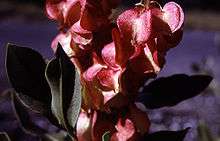Rumex venosus
| Rumex venosus | |
|---|---|
 | |
| Scientific classification | |
| Kingdom: | Plantae |
| (unranked): | Angiosperms |
| (unranked): | Eudicots |
| (unranked): | Core eudicots |
| Order: | Caryophyllales |
| Family: | Polygonaceae |
| Genus: | Rumex |
| Species: | R. venosus |
| Binomial name | |
| Rumex venosus Pursh | |
Rumex venosus is a species of flowering plant in the knotweed family known by the common names veiny dock,[1] winged dock, and wild-begonia (it is not related to genus Begonia). While not of any particular agricultural use, its cousins Rhubarb and Buckweat are. It is native to central and western North America, from southern parts of the Canadian prairies, through to Mexico.
It can be found in many types of habitat, including sagebrush, dunes, and other sandy areas. It is commonly found in heavily grazed pastures as livestock tend to avoid it, allowing veiny dock to spread uninhibited.
It is a perennial herb producing decumbent, spreading, or upright stem 10 to 40 centimeters tall, usually with a few branches. It grows from a creeping rhizome. The light green leaves are lance-shaped to oval with smooth or wrinkled edges, growing 5-10 centimeters long and 1-6 centimeters wide. The inflorescence grows as either an axillary or terminal panicle and is densely flowered. The flowers themselves are not showy, being green and inconspicuous. They have 6 sepals, 6 stamen, and 1 pistil. The bright, pink colour of the flowers comes from the inner sepals of each flower when the fruit matures. The sepals enlarge to about 1.5 centimeters across, turning quite veiny, and surround the achene. Flowering period is throughout the summer.
Uses
Like all docks, Rumex venosus is considered edible, but the young leaves tend to be too sour to be palatable. Since the leaves and shoots remain tender for most of the growing season, docks make good cooked vegetables, similar to beet shoots, but will likely require multiple boiling to remove some of the bitter taste. The achenes can be boiled into a mush or ground into a flour, but the process of removing the seeds from the chaff is too time consuming to be worth the effort. Docks contain high levels of vitamin C and beta-carotene, with Rumex crispus having the highest levels, greater than that of oranges and carrots respectively. The leaves have been used to relieve the burning of stinging nettle, and can be dried and used as a powder to help speed the healing of wounds. Docks contain anthraquinones, which have laxative and antibacterial properties, as well as stopping the growth of some parasites and fungi. There is also evidence that Native Americans used the roots to make an orange dye.
Precautions
While considered edible, Rumex venosus contains toxic oxalates which can cause vomiting, cramps, or diarrhea. While a large quantity would have to be consumed in order to experience these toxic effects, it is recommended that people with kidney problems, the elderly, or small children refrain from using docks. Calcium is known to neutralize the oxalates, making it advisable to serve the vegetable with a cream sauce.
References
- ↑ "Rumex venosus". Natural Resources Conservation Service PLANTS Database. USDA. Retrieved 26 October 2015.
External links
- Calflora Database: Rumex venosus (Veiny dock, Winged dock)
- Jepson Manual Treatment
- USDA Plants Profile
- Flora of North America
- Washington Burke Museum
- Photo gallery